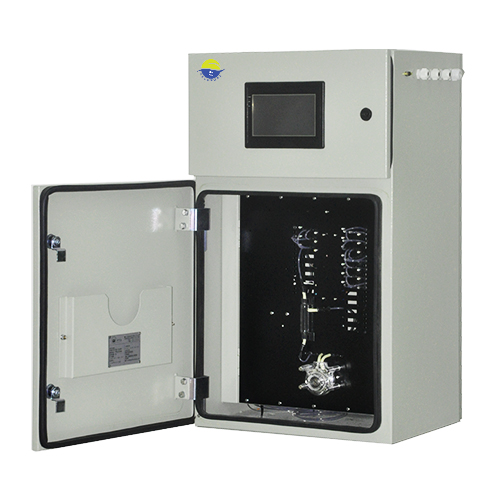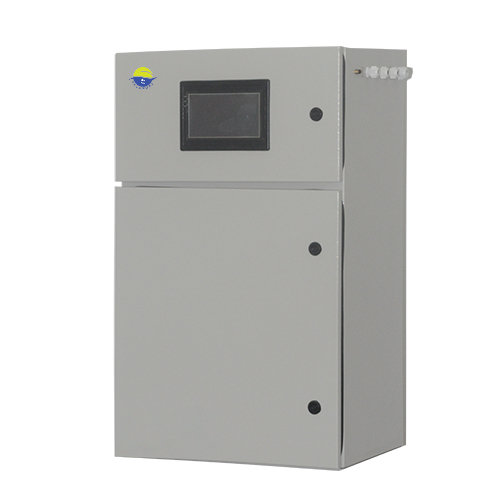KLD-C-NH3-N & PO4 & TP is an automatic on-line analyzer independently developed by KLD. Using imported CPU, highly precise signal processor and simple but steady loop flow system to effectively reduce signal fluctuation and to ensure the accuracy and stability of data. Complete separation between electronics and hydraulics allows long-term & stable running. It is suitable for several types of water matrix like river water, surface water and industrial effluent.
Features
1. Robust & Reliable
Designed for on-line industrial and environmental applications. Complete separation between electronics and hydraulics allows long-term stable operations.
2. Precise Reagent Dosage
CPU controlled photoelectric dosing system for accurate reagent dosage. Simple & steady structure ensures long-term service life.
3. Easy Installation
Delivered after a long & successful series of factory tests, it is ready for installation and setup. To start monitoring just need to connect reagent tubes, sample tube, water tube, waste tube and power supply, then set up the parameters.
4. Automatic Calibration
The analyzer performs calibration according to the calibration interval and type set up by users. If the result exceeds selected limits, the original calibration parameters will not be updated and an alarm signal will be outputted.
5. Automatic Monitoring
Measuring interval can be freely set up by users. Between two measurements the analyzer remains in standby.
Benefits
Ø Automatic monitoring system gives alarm signal in abnormal condition. Easy and low maintenance; Low operating cost.
Ø 4-20mA analog signal output; standard RS232, RS485 digital signal output, MODBUS protocol.
Ø New signal processor reduces signal fluctuation to ensure the accuracy and stability of data.
Ø Highly precise peristaltic pump extends the service life of pump tubes.
Ø Automatic restart when normal power supply after accidental power down.
Ø Remote control with local or remote PC connection.
Ø Low reagent consumption; short preparation time.
Ø Automatic diagnosis function. Identification and alarm for reagent shortage.
Ø Instrument operating signal output function.
Ø 3000 groups of data storage and USB download for analysis data and running log.
Ø Easy operation, no special training is required.
Ø Controllable running of water pump and free setup for the sampling time of the pump.
Ø Security management function, automatic record and storage for all control operations. Read-only storage.
Ø 2-level operation & management authorization: The system administrator can have all system operation and general operators can only perform routine maintenance & operation.
Measuring Principle
NH3-N: The sample after proper filtration is pumped into the reactor, where R1(phenol, sodium nitroprusside, potassium tartrate and potassium hydroxide) and R2 (sodium dichloro isocyanurate) are injected and heated to 50°C. Sample reacts with phenol, potassium tartrate and sodium dichloro isocyanurate under alkaline conditions (using sodium nitroprusside as a catalyst ). After fully mixing and reaction, the analyzer measures ABS value of blue substances produced by reaction at the specific wavelength, then calculates sample concentration according to the stored calibration data.
PO4: The sample after proper filtration is pumped into the reactor, where molybdate and antimony potassium tartrate are injected. Then, injecting ascorbic acid into the sample. After fully mixing and reaction, the analyzer measures ABS value of blue substances produced by reaction at the specific wavelength, then calculates sample concentration according to the stored calibration data.
TP: The sample after proper filtration is pumped into the reactor, where injected with acid reagent and heated to 95°C, to convert all inorganic phosphides into orthophosphate. Through adding oxidation reagents and passing through a UV digestion step, to convert the rest of organic forms of phosphide into orthophosphate. Then, injecting antimony potassium tartrate, sodium molybdate and ascorbic acid into the sample. After fully mixing and reaction, the analyzer measures ABS value of blue substances produced by reaction at the specific wavelength, then calculates sample concentration according to the stored calibration data.
Specifications
Measuring Principle | NH3-N | PO4 | TP | ||
Colorimetric, Phenate Method | Colorimetric, Molybdate Ascorbic Acid Method | High Temperature Oxidation & UV Digestion, Colorimetric, Molybdate Ascorbic Acid Method | |||
Operating Management | Security management and 2-level operation management function | ||||
Measuring Type | Manual or automatic with interval | ||||
Measuring Interval | Programmable; reverse control available by RS232 | ||||
Measuring Time | 12 minutes | 6 minutes | 30 minutes | ||
Measuring Range | 0.01~0.5/5mg/L, other ranges available on request | ||||
Calibration Type | Manual or automatic with interval | ||||
Precision | ≤ 5% | Zero Drift | 5%F.S | ||
Accuracy | ±5% | Range Drift | 5%F.S | ||
Signal Output | Standard 4-20mA analog output, Standard RS232/RS485 digital output, MODBUS Protocol | ||||
Alarm | High limit alarm, low limit alarm, reagent shortage alarm, calibration error alarm (standard) | ||||
Sample and Waste Delivery | Pressure free | Reagent Temperature | 10-30°C | ||
Reagent Replacement | 3~4 weeks (depending on the ambient temperature) | ||||
Ambient temperature | 5-40°C | Protection | IP55 | ||
MTBF | >720h | Display | Color touch screen | ||
Power supply | 220V AC±10%; power 90W | ||||
Weight | 60kg (without reagents) | ||||
Dimension | 1600×500×400mm(H×W×D) (with the height of base) | ||||
Optional Functions
Dual-channel
One analyzer to monitor on-line for 2 outlets.
Reagent Cooling
Longer reagent service life and less reagent replacing.
Alarm Function
DI water low limit alarm and waste liquid high limit alarm function.
Automatic Dilution Function
Automatic dilution function for high concentration sample.
Mini Printer
Print data after measurement.

